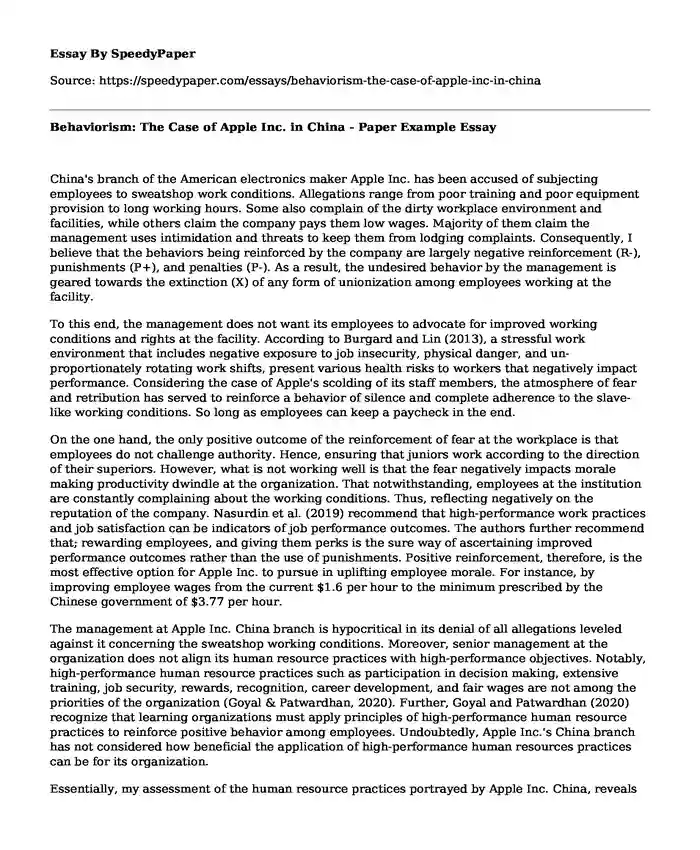China's branch of the American electronics maker Apple Inc. has been accused of subjecting employees to sweatshop work conditions. Allegations range from poor training and poor equipment provision to long working hours. Some also complain of the dirty workplace environment and facilities, while others claim the company pays them low wages. Majority of them claim the management uses intimidation and threats to keep them from lodging complaints. Consequently, I believe that the behaviors being reinforced by the company are largely negative reinforcement (R-), punishments (P+), and penalties (P-). As a result, the undesired behavior by the management is geared towards the extinction (X) of any form of unionization among employees working at the facility.
To this end, the management does not want its employees to advocate for improved working conditions and rights at the facility. According to Burgard and Lin (2013), a stressful work environment that includes negative exposure to job insecurity, physical danger, and un-proportionately rotating work shifts, present various health risks to workers that negatively impact performance. Considering the case of Apple's scolding of its staff members, the atmosphere of fear and retribution has served to reinforce a behavior of silence and complete adherence to the slave-like working conditions. So long as employees can keep a paycheck in the end.
On the one hand, the only positive outcome of the reinforcement of fear at the workplace is that employees do not challenge authority. Hence, ensuring that juniors work according to the direction of their superiors. However, what is not working well is that the fear negatively impacts morale making productivity dwindle at the organization. That notwithstanding, employees at the institution are constantly complaining about the working conditions. Thus, reflecting negatively on the reputation of the company. Nasurdin et al. (2019) recommend that high-performance work practices and job satisfaction can be indicators of job performance outcomes. The authors further recommend that; rewarding employees, and giving them perks is the sure way of ascertaining improved performance outcomes rather than the use of punishments. Positive reinforcement, therefore, is the most effective option for Apple Inc. to pursue in uplifting employee morale. For instance, by improving employee wages from the current $1.6 per hour to the minimum prescribed by the Chinese government of $3.77 per hour.
The management at Apple Inc. China branch is hypocritical in its denial of all allegations leveled against it concerning the sweatshop working conditions. Moreover, senior management at the organization does not align its human resource practices with high-performance objectives. Notably, high-performance human resource practices such as participation in decision making, extensive training, job security, rewards, recognition, career development, and fair wages are not among the priorities of the organization (Goyal & Patwardhan, 2020). Further, Goyal and Patwardhan (2020) recognize that learning organizations must apply principles of high-performance human resource practices to reinforce positive behavior among employees. Undoubtedly, Apple Inc.'s China branch has not considered how beneficial the application of high-performance human resources practices can be for its organization.
Essentially, my assessment of the human resource practices portrayed by Apple Inc. China, reveals that the company is intentionally frustrating efforts by its staff members to unionize. Whereas this strategy may save on costs associated with paying wages and providing a conducive work environment, the cost implications for dwindling employee morale will manifest in poor work performance. Eventually, resulting in overhead costs from a high rate of turnover (Jeong & Shin, 2017). Jeong and Shin (2017) recommend that a learning organization is one that encourages high-performance work practices through advancing autonomy and creativity in the workplace. I hold that the management should not only change its attitude of absolute control over employees. An imperial governance strategy will only spark a rebellion from junior staff members. Instead, the organization's management should focus on building capacity by renegotiating wage terms as well as the working conditions of employees. By addressing employee concerns, the organization can utilize high-performance human resource practices to positively reinforce the behavior of compliance and job satisfaction. Hence, improving individual staff performance and eventually, overall company performance.
References
Burgard, S. A., & Lin, K. Y. (2013). Bad jobs, bad health? How work and working conditions contribute to health disparities. American Behavioral Science, 57(8), 1105-1127. https://scihub.wikicn.top/10.1177/0002764213487347
Goyal, C., & Patwardhan, M. (2020). Strengthening work engagement through high-performance human resource practices. International Journal of Productivity and Performance Management, 1(2), 1-18. https://scihub.wikicn.top/10.1108/IJPPM-03-2020-0098
Jeong, I., & Shin, S. J. (2017). High-performance work practices and organizational creativity during organizational change: A collective learning perspective. Journal of Management, 45(3), 909-925. https://doi.org/10.1177%2F0149206316685156
Nasurdin, A. M., Tan, C. L., & Khan, S. N. (2019). Can high-performance work practices and satisfaction predict job performance? An examination of the Malaysian private health care sector. International Journal of Quality and Service Sciences, 1(1), 1-20. https://scihub.wikicn.top/10.1108/IJQSS-06-2019-0090
Cite this page
Behaviorism: The Case of Apple Inc. in China - Paper Example. (2024, Jan 15). Retrieved from https://speedypaper.com/essays/behaviorism-the-case-of-apple-inc-in-china
Request Removal
If you are the original author of this essay and no longer wish to have it published on the SpeedyPaper website, please click below to request its removal:
- Nonverbal Social Behavior - Free Essay About Observational Exercise
- Essay Sample on Crime and Public Transport
- Tina's Restaurant. Paper Example
- Free Essay Sample. Managing the Product
- Reflective Review - Free Essay Example
- Google: A Super-Powerful Source of Information and Solutions - Essayy Sample
- Free Paper Sample on German Warplane Technology During World Wars
Popular categories





